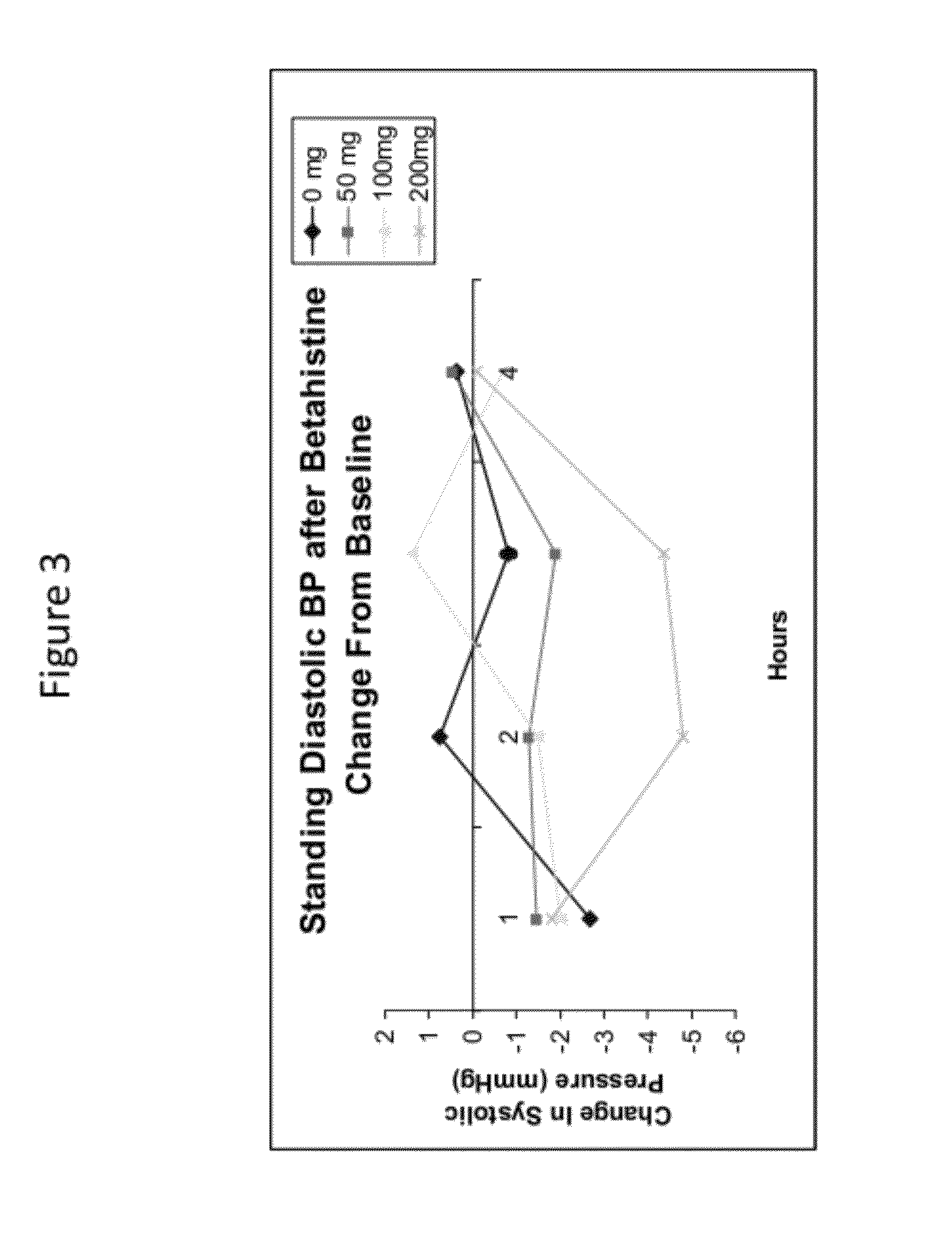Treatment methods employing histamine H3 receptor antagonists, including betahistine
a technology of histamine h3 receptor and treatment method, applied in the field of pharmaceutical and medicinal arts, can solve the problems of increased appetite/weight gain, increased histamine levels in the brain, and significant antihistaminic activity of tcas, which are less effective than maois in atypical depression, and achieve significant antihistaminic activity, reduce the metabolism of histamine, and increase the effect of histamine in the brain
- Summary
- Abstract
- Description
- Claims
- Application Information
AI Technical Summary
Benefits of technology
Problems solved by technology
Method used
Image
Examples
example 1
[0062]This example illustrates use of betahistine in treatment of depression, and, in particular, treatment of atypical depression.
[0063]Dosing begins with 48 mg per day, and subsequently increases up to the range of 150-300 mg / day if needed. Alternatively, some patients may experience sustained benefit with a twice a day or three times per day dosing schedule. The rationale for the effectiveness of this dosing schedule, which is considerably higher than that used for treatment of Meniere's disease, is based on two key points. First, evidence from animal studies show that betahistine concentrations in the CNS after peripheral administration of the drug are approximately half the levels achieved in the plasma with a particular dose (Guth, P. S. (2001) “The pharmacology of betahistine in the context of the vestibular system,”Acta Otorhinolaryngol Ital, 21 (3 Suppl 66): 16-23). This suggests that higher doses are needed to produce direct CNS effects. Moreover, Tighilet et al. (2005) de...
example 2
[0068]This example illustrates a method of treating Binge Eating Disorder (BED) (see http: / / www.ahrq.gov / downloads / pub / evidence / pdf / eatingdisorders / eatdis.pdf) using betahistine hydrochloride.
[0069]Treatment may be initiated with 48 mg per day in a formulation achieving a minimum sustained concentration in plasma of 200 ng / ml for a minimal period of 4-6 hours. Depending upon intensity and duration of suppression of both appetite and binge episodes in a patient suffering from BED, dose can subsequently be increased up to a range of 96-300 mg / day if needed, to produce a reduction in BED specific associated symptoms. This higher subsequent dose range (96-300 mg / day) is necessary to provide higher sustained plasma concentrations (ie. greater than 400 ng / ml) so as to cross the blood-brain barrier in sufficient concentration for betahistine and its primary metabolite, 2-pyridylacetic acid, to produce specific brain activation in the hypothalamus and other brain centers to reduce craving, ...
example 3
[0072]The following example illustrates the use of betahistine to treat Prader-Willi Syndrome (PWS). As noted above, PWS is a genetic disorder which results from the absence of expression of the paternal copy of as yet unidentified maternally imprinted gene(s) at the genetic locus 15 (q11-13). A recent epidemiological study estimates an incidence of 0.1 in 25 000 births, and a population prevalence of 0.1 in 50 000 making it an orphan disease. In a patient with PWS there is a rapid onset of hyperphagia and obesity between the ages of 1-6 years, which is sustained into adulthood. Without adequate dietary control, the extreme hyperphagia in PWS leads to obesity-related morbidity, such as cardiopulmonary disease, type 2 diabetes mellitus, thrombophlebitis, chronic leg edema and mortality at 35 years. The abnormal feeding behavior includes a morbid obsession with food, food stealing, stealing money to buy food, hording and foraging, pica behavior, reduced satiety, and earlier return of ...
PUM
| Property | Measurement | Unit |
|---|---|---|
| concentration | aaaaa | aaaaa |
| concentration | aaaaa | aaaaa |
| time | aaaaa | aaaaa |
Abstract
Description
Claims
Application Information
 Login to View More
Login to View More - R&D
- Intellectual Property
- Life Sciences
- Materials
- Tech Scout
- Unparalleled Data Quality
- Higher Quality Content
- 60% Fewer Hallucinations
Browse by: Latest US Patents, China's latest patents, Technical Efficacy Thesaurus, Application Domain, Technology Topic, Popular Technical Reports.
© 2025 PatSnap. All rights reserved.Legal|Privacy policy|Modern Slavery Act Transparency Statement|Sitemap|About US| Contact US: help@patsnap.com



